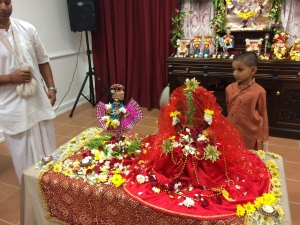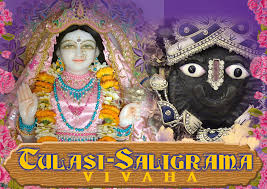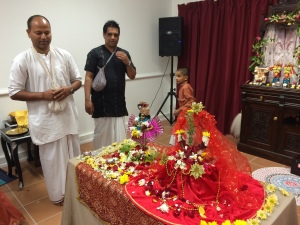18 Nov 2014 – Utpanna Ekadashi
More About Advancing in Bhakti-Yoga
→ The Enquirer

More About Advancing in Bhakti-Yoga
This continues my previous article.
Unsteady Practice
I think a very good translation of utsāha-mayī, the very first stage of practicing bhakti, is fanaticism.
Unsteady practice (aniṣṭhitā-bhajan) boils down to not really having a clear picture what “devotion” really is, and not really bing particularly convinced (therefore) that its really worth the effort to pursue.
So the four phase of unsteady practice after fanaticism wears off, are all about developing the determination to pursue bhakti, and the stage that follows that is all about getting a clear picture of what devotion really is. Specifically, this final stage of unsteady practice is about being able to differentiate genuine devotion to Krishna, from “devotion” employed as a device to get three-meals and a cot in an āśrama, or better (to get disciples, admirers, fans, etc.).
Purification
Once we are (a) fairly convinced that bhakti is worth the effort, and (b) can really distinguish sincere from insincere devotion – the next stage focuses on the effort to rid ourselves of insincere devotion and become fully sincere.
This stage is called anartha-nivṛtti – purification (“getting rid of unwanted things,” you could say).
Sri Viśvanātha points out four categories of impurities, and puts them in a certain order, the order in which they naturally become our main focus.
The First Group of Anarthas: Negative Things
The first category is duskṛtyuttara-anartha — impurities arising from “bad deeds.” Thankfully, he also defines what he means by this term. He says it refers to the five ”kleśa (calamities):
1) avidyā — “Ignorance”
2) asmitā — “Selfish worries”
3) rāga — “favoritism”
4) dveśa — the opposite of favoritism, maybe we call it “partiality.”
5) abhiniveśa — being “wrapped up” in the external world.
All five are consequential. In other words, the later results from the former, and the first is the root of them all. So, it would seem clear that a key trait of attaining the stage of anartha-nivṛtti (which I would make, by the way, as the point at which we pass beyond being a “beginner”), is that we start to work hard to get vidyā.
This means we start to work hard to clearly understand Śrī Bhāgavata, and the explanations and elaborations of Śrī Bhāgavata given by Śrī Caitanya’s followers, especially the six Gosvāmī of Vṛndāvana. So, a real key to digging into anartha-nivṛtti is study.
Not everyone is a bookworm, so study isn’t always about books. But somehow or other, we need to really get clear about what Gauḍiya Vaiṣṇava siddhānta is, and what it’s not.
Clarity about the philosophical essentials will deflate the other four kleśa (always being worried about oneself, showing favoritism and partiality, and being so wrapped up in nonessentials and externals.
The Second Group: “Positive” Things
The second group of anartha is sukṛtyuttara — its the stuff that comes as a result of “good deeds.” This means all the wealth and beauty and power and good fortune that we have.
Why is this ”anartha”? It brings a sense of importance and prestige which is antithetical to the fundamental mood of bhakti.
Even if we are wealthy, we should live simply, like an ordinary person, and use our money charitably.
Even if we are beautiful, we shouldn’t flaunt it. We should dress and ornament ourselves modestly and help others feel beautiful.
Even if we are powerful, we should only use power when our responsibilities require us to do so. We should in all other circumstances give space for other people to freely express their will and intention.
By (a) not over-indulging in our good fortune, and (b) sharing our good fortune with others, we become purified from the second group of anartha.
The Third Group: Offenses
Mainly we have to concentrate, Śrī Viśvanātha explains, on offenses regarding Krishna’s names. Other kinds of offenses are also to be considered, but the main thing is far and away offenses to Krishna’s name.
He gives an elaborate explanation of the offenses and how to avoid them. I’ve tried to represent his advice in my book, To Dance in the Downpour of Devotion.
The primary offense is offenses towards people who chant Krishna’s name. The primary remedy is the attempt to chant sincerely and attentively.
The Fourth Group: “Perks”
The fourth group is quite similar to the last stage of aniṣṭhitā-bhajan — trying to use bhakti as a means for earning a livelihood, keeping a roof over our head, filling our bellies, getting respect, etc.
The cure here is not to accept remuneration for devotional service. We should not accept salary for our bhakti seva. Remuneration is not limited to finance. We should not accept praise, we should divert praise to its rightful sources. We should not accept special accommodations, meals, seats, garlands, etc in Krishna’s temples and in āśrama’s of devotees.
Some degree of preferential treatment can be accepted in lieu of social standards (like being an older person) or practical matters (like being ill). But these should always be reduced to bare minimum.
For example, we may be older, more advanced and more learned than the rest of the devotees in an āśrama or temple, but this doesn’t mean we deserve our own apartment in the ashram with a french maid, and a royal throne. It is enough to accept a special blanket or cot that is slightly more than what the others use. It is enough to sit on a slightly more decorated mat.
In this way, we destroy the fourth category of unearth.
Steady Bhajan
When we have made significant progress uprooting the four types of impurities, we naturally begin to concentrate on our devotional practice itself. (which by the way is remembrance,smaraṇ, as a result of hearing, śravaṇa, affectionate glorification of Śrī Krishna’s name-form-qualities-pastimes, kīrtan.)
Here Śrī Viśvanātha says that there are five things that prevent steady kīrtan-śravaṇa-smaraṇa:
1) Sleepiness — this is very blatant and only happens when we are just barely beginning to aspire for steady bhajan (or in very extremely challenging circumstances).
2) Distraction — we aren’t concentrating on the kīrtan (etc), we’re just going through the motions, but thinking about (and even doing) other things.
3) Apathy — though we’re not distracted, we’re also not particularly paying much attention to the kīrtan, not feeling much for it.
4) Faults — being apathetic, our focus is quickly overthrown by our faults. What faults? Śrī Viśvanātha says “anger, greed, pride, etc.” In other words, we focus on chanting for a moment, but then start thinking about something that makes us angry, or something we really want to accomplish, or something that would enhance our pride, etc.
5) Tasting Pleasure — This is the last vestige of unsteady bhajan. Surpassing this one is rightfully called fully situated in niṣṭhā. Here, our focus is able to remain for some time away from being diverted into anger, greed, pride, etc. — but when some opportunity comes to enjoy something, we lose focus and even stop the chanting to enjoy it. When this tendency is surpassed, one is truly at the stage of niṣṭhitā-bhajan.
There is a secret embedded in the way Śrī Viśvanātha terms “Tasting Pleasure”. He calls it rasāsvāda. The secret is that all five faults remain because we as yet have no ruci – no actual ability to taste the joy of devotion of Krishna, therefore we are distracted and so on.
The next stage after niṣṭhā is titled ruci — and is all about developing a taste of the actual beauty and bliss in bhakti-yoga. Hopefully that can be a topic of a post in the near future.
HH Prahladananda Swami – Shlokas for Shelter / SB 10.72.04
→ Kalachandji's Audio Archive
4 Minute Krishna Podcast @ BKS Iyengar Yoga – Supreme Reciprocation
→ Kalachandji's Audio Archive
4 Minute Krishna Podcast @ BKS Iyengar Yoga – 3 Stages of Life
→ Kalachandji's Audio Archive
BG 18.26 The Darshan Room – Rufus the sock puppet says 12 Nov 2014 at The Darshan Room
→ Kalachandji's Audio Archive
Today I Will Hear The Sound
→ Japa Group
Every second we are chanting we make that decision, we just need to make the right decision to hear Krsna's sound vibration and ignore the sound of the mind.
Bhagavatam-daily 30 – 11.07.20 – To become your own guru, observe and infer in harmony with guru
→ The Spiritual Scientist
Harinama Perth City – 14 November 2014 (Album 65 photos)
The…
→ Dandavats.com

Harinama Perth City - 14 November 2014 (Album 65 photos)
The Hare Krishna chant is called the maha-mantra, the great, exalted mantra above all other Vedic mantras, because simply chanting the Hare Krishna maha-mantra brings so many beneficial effects. (Srimad Bhagavatam, 9.1.17 Purport).
http://goo.gl/EGLaIZ
Radha Krishna Deity gifted to Bollywood Actor and Superstar…
→ Dandavats.com

Radha Krishna Deity gifted to Bollywood Actor and Superstar Salman Khan’s sister Arpita Khan’s upcoming wedding ceremony by one of her staff member’s
“My staff gifted me the nicest & sweetest wedding gift!blessed to be surround by such lovely people”- Arpita S Khan on Twitter
ISKCON Devotee’s Performance on the Russian “Voice”
→ ISKCON News

Pierre Edel (Premamaya Vasudeva Das) on tThe Voice of Russia. Check out the story on ISKCON News: http://iskconnews.org/the-voice-contestant-brings-krishna-conscious-message,4635/
Caring for Ramadevi devi dasi
By now, many have heard that our…
→ Dandavats.com

Caring for Ramadevi devi dasi
By now, many have heard that our dear friend, auntie and godsister Ramadevi dasi has been diagnosed with stage 4 large cell non-Hodgkin’s lymphoma, a cancer of the lymphatic system. This type of cancer has a very high recovery rate if treated properly. Friends and godsisters of Ramadevi dasi are anxious to assist her in every possible way at this time in her life.
http://goo.gl/oq27LG
Ananta-rupa asks about how it is that acarya’s sometimes have apparently contradictory views and other questions
→ SivaramaSwami.com
Kartik 2014: Initiations in Vrindavana (Album 14 photos)
It is…
→ Dandavats.com

Kartik 2014: Initiations in Vrindavana (Album 14 photos)
It is imperative that all devotees in Krishna consciousness practice chanting some mantra. Certainly one should chant the Hare Krishna mantra, which is the maha-mantra, or great mantra, and also one should practice chanting cintamani-prakara-sadmasu or the Nirsimha strotra (ito nrsimhah parato nrsimho, yato yato yami tato nrsimhah) (Srimad-Bhagavatam, 8.3.1 Purport)
http://goo.gl/KrDmDH
Always remember Sri Vrndavan!! (Album 95 photos)
The sastras…
→ Dandavats.com

Always remember Sri Vrndavan!! (Album 95 photos)
The sastras recommend which names we should chant, such as Hare Krishna, Hare Krishna, Krishna Krishna, Hare Hare. It is not that we have to search for some name or manufacture one. Rather, we must follow the saintly persons and the sastras in chanting His holy name. (Srimad-Bhagavatam, 8.1.13 Purport)
http://goo.gl/r356Wy
What is Śāstra?
→ The Enquirer
What is Śāstra?
This question is the first topic of Jīva Gosvāmī’s Ṣaḍ-sandarbha. I’ll summarize and include a concept or two borrowed also from Nāma Cintāmaṇī of Kānupriya Govāmī.
Śāstra is valid-knowledge, which in Sanskrit is called veda. Veda is embedded within creation itself from the source of creation, Viṣṇu. Thus a great deal of knowledge comes automatically, instinctually (as in, how to balance, how to regulate heart beat, how to repair wounds, how to grow, how to breathe, how to mate, etc.). But the more complex knowledge available mainly to species beginning with human beings is not imposed by instinct but is available only to those who want it and seek it.
Brahmā is the first seeker and realizer of the higher knowledge embedded by Viṣṇu in the universe. He explains what he realizes in words, and those words constitute the verbal “Veda.”
Gradually, Brahmā’s veda becomes confusing to people, and as Dvāpara Yuga advances it becomes almost completely messed up. Therefore towards the end of every Dvāpara Yuga, someone fills the role of “Vyāsa” (Editor) and recompiles Brahmā’s veda.
The main topic of the Veda is “Sacrifice” — how to live in such a way as to not be “sinful” or “evil” yet also achieve what you want to achieve. There are four parts to Sacrifice, so the Vyāsa’s create four books about Sacrifice, Ṛg, Yajur, Sāma and Atharva.
Then Vyāsa and his followers compile elaborations on the four Vedas, consisting of the parts of Brahmā’s Veda which are not directly about sacrifice. These mainly become known as the Upaṇiṣads.
But a special section is compiled which is easy to read, speak, and understand, but which contains all the knowledge of Brahmā’s veda completely (Pūrṇam), this section is called the Purāṇa, sometimes known as the “Fifth Veda.”
There are 18 major Purāṇa compiled by Vyāsa. They are superior to the Upaṇiṣad’s and Veda because (a) everyone can relatively easily access them, and (b) the Vedas and upaniṣads quickly become degraded and large portions of them disappear immediately as Kali Yuga arrives.
Of the Puāṇa, 6 are primarily directed towards those with tamasic inclinations, 6 for those with rajasic, and 6 for those with sattvik. The most sattvik is the Bhāgavata-Purāṇa.
This Bhāgavata Purāṇa is a prototype of the Śrīmad Bhāgavatam, it is not the full Śrīmad Bhāgavatam.
In some Dvapara-Yugas, such as this one, rarely (once in 1000), Krishna himself appears, so the Vyāsa feels a special impetus to create an appropriate Śāstric compilation to serve his appearance. After consulting with Nārada and achieving a special samādhi under his inspiration, Vyāsa then recompiles the Bhāgavata Purāṇa, which becomes known as Śrī Bhāgavata / Śrīmad Bhāgavatam.
The Śrīmad Bhāgavatam is the highest form of all Brahmā’s original revelations, and in fact is even higher than the original, because the Vyāsa who compiles it (Kṛṣṇa Dvaipayaṇa) is a śaktyāveśa avatāra of Viṣṇu, and the speaker Śuka, is uniquely realized.
Vyāsa teaches the essence of Śrī Bhāgavata to his son, Śuka. Śuka uses it to answer all of Parīkṣit Mahārāja’s questions. Sūta is present there, and recounts it to answer the questions of Śaunaka and the Naimiṣāraṇya Ṛṣis. This is the form of Śrī Bhāgavata we have today.
No one except Viṣṇu, Brahmā, and Vyāsa writes śāstra. Actually, no one but Viṣṇu creates śāstra. Brahmā and Vyāsa simply give specific form to what Viṣṇu creates.
What are the Writings of the Goswāmīs, Etc?
In the 1 in 1000 times that Krishna appears in Dvāpara, he soon thereafter realizes that he didn’t accomplish the objective of his descent (to spread Vraja-prema), so in Kali-Yuga he then becomes a premī-bhakta and again appears (as Śrī Kṛṣṇa Caitanya). He appears with his confidential assocaites.
He and those associates provide the inspiration that makes full use of Vyāsa’s Śrī Bhāgavata and allows Krishna prema to spread relatively widely throughout the world.
The writings of the Goswāmīs are direct expositions of the content of Śrī Bhāgavatam. This is a literal statement, and as you study the Bhāgavata deeply and the Goswāmī books literally, this fact stands clearly right in front of your nose.
What about “Sādhu” and “Guru”
These people explain and exemplify the Śrī Bhāgavata and other Śāstra. If they write or say things that are not completely supported by the conclusions of Śrī Bhāgavata, then their teachings and their followers are not counted among “Vedic” schools of thought. Buddhists are an example.
Sādhu and Guru have no independent authority apart from the śāstra. All philosophical authority is in the Śrī Bhāgavata and not elsewhere.
The members of a particular school or line will of course take full avail of the explanations of Śrī Bhāgavata given by their founders and ācāryas. Thus we approach the Śrī Bhāgavata through the Six Goswāmīs and their faithful followers. “Faithful” means “with fidelity.” One who comes to conclusions other than the conclusions arrived at by Śrī Jīva, Śrī Rūpa, etc. is not “faithful” – other credentials having no bearing to counterweight this judgement.
Thus no “new śāstras” are ever made, but something like that appears to happen in the attempt to explain the fundamental śāstra to new points of view. In time this inevitably causes the śāstra to lose coherence and integrity, which is why there is a scheduled necessity for Vyāsa.
The works of the six goswamīs, are not śāstra, but they are elaborations and explanations of Śrī Bhāgavata, by the followers of Śrī Caitanya.
November 15th, 2014 – Darshan
→ Mayapur.com
The post November 15th, 2014 – Darshan appeared first on Mayapur.com.
Ekachakra Retreat 2014
→ Mayapur.com
Please come and chant with us……. in Japa as well as in Kirtan….. From 27th to 31st of December 2014 in Ekachakra Dham, India This retreat is open to one and all – men as well as ladies YOU ARE MOST WELCOME TO JOIN US TO: Deepen your relationship with the Holy Name. Spend these days […]
The post Ekachakra Retreat 2014 appeared first on Mayapur.com.
Varshana 2014: Srimati Radharani’s transcendental…
→ Dandavats.com

Varshana 2014: Srimati Radharani’s transcendental playground (Album 77 photos)
If we simply place ourselves at the lotus feet of Krishna by taking to Krishna consciousness and keeping always in touch with Him by chanting the Hare Krishna mantra, we need not take much trouble in arranging to return to the spiritual world. By the mercy of Sri Caitanya Mahaprabhu, this is very easy. (Srimad-Bhagavatam, 7.15.53 Purport)
http://goo.gl/aZ2R3U
Gopal’s Garden for Little Vaishnavas – New Vrindaban Preschool Reopens
→ New Vrindaban Brijabasi Spirit
New Vrindaban Preschool Reopens
by Lilasuka dasi
The academic school in New Vrindaban has gone through many changes throughout the years. From “Nandagram School” back in the 80’s, to the “New Vrindavan School” in the 90’s, to the current “Gopal’s Garden Home School Co-op”, all ages of kids and teachers have come and gone. Many of the graduates have expressed fond memories of their time spent in those Nandagram classrooms.
These days, a new wave of enthusiasm is hitting New Vrindaban in the form of a preschool! It is a welcome phenomenon that truly happened by surprise. Recently, one of the newest mothers in New Vrindaban was searching for a babysitter for a few days a week. The search didn’t exactly bear fruit, but something even better took place. In talking to several other mothers with young children, the possibility of a preschool came up. The idea was an immediate hit.
That same weekend, on Nov. 9, 2014, Mother Ruci held a meeting with the four interested mothers. Mother Ruci said, “I was totally surprised at the enthusiasm, energy and commitment coming from these mothers for a preschool. It must be that the time is right for this to happen. I think it’s a great idea and I’m enlivened. We’re ready for the New Vrindaban Home School Co-op to expand.”
The very next morning, all four mothers were down at the school building, working together to clean out the preschool classroom and bring in the paraphernalia provided by Mother Ruci. Lalita Gopi dasi, who cares for another mother’s toddler, Nadia, and who was instrumential in getting the project off the ground, was found enthusiastically sweeping the new classroom and arranging the tables. Sundari dasi said, “I’m very excited about this class for my two year old daughter, Bhumi. Just having this class here will attract more families with young children to New Vrindaban, I’m sure of it.”
Vilasini dasi won’t be able to personally assist in the classroom, as she is going to school for nursing and also working, but she and her husband are very excited for their three year old, Malini, to attend. She confirms, “If they need us to shop for the class, I’d love to do that!”
One young mother, Priti dasi, was born in New Vrindaban back in the early ‘80’s and is a graduate of the school herself. She now has two little children of her own, one of whom will be attending the preschool. Priti said, “When I heard about the possibility of this preschool, I was very excited. My three year old, Rama, is ready for this. I’m really enthusiastic about helping to provide him a situation where he can learn to socialize with other kids his age in a Krsna conscious setting.”
Prabhupada Envisions “Every Home, Every Cottage” in New Vrindaban as a Temple
→ New Vrindaban Brijabasi Spirit

Srila Prabhupada visits Sri Sri Radha Vrindaban Natha at the original New Vrindaban farmhouse, June 1976.
“In Vrindavan there are so many temples, they say 5,000, or in Vrindavan every home, every cottage is a temple. As far as possible, try to develop New Vrindaban on this standard.” – Srila Prabhupada, August 1970.
Click here to read the rest of the letter at the Brijabasi Spirit website.
2014 11 02 SB 10 52 24 Being Eager to hear about Krishna Radhanath Swami ISKCON Chowpatty
→ Gouranga TV - The Hare Krishna video collection
2014 11 02 SB 10 52 24 Being Eager to hear about Krishna Radhanath Swami ISKCON Chowpatty
Bhaktivedanta Research Centre Acquires Manuscripts From Advaita…
→ Dandavats.com

Bhaktivedanta Research Centre Acquires Manuscripts From Advaita Acharya’s Line
The Bhaktivedanta Research Centre in Kolkata, India has added some new treasures to its vast library of over 15,000 works that includes all the major Puranas and Vedas and many important and rare works by Vaishnava acharyas.
Amongst the recent acquisitions are seven hand-written manuscripts donated by Sri Sanjay Goswami of Vrindavan, a 14th generation descendent from Chaitanya Mahaprabhu’s intimate associate Sri Advaita Acharya.
http://goo.gl/bI92PX
Flying above Mayapur (Album of 15 beautiful photos)
This album…
→ Dandavats.com

Flying above Mayapur (Album of 15 beautiful photos)
This album shows the beautiful Temple of Vedic Planetarium at sunrise this morning from above. So much more work has been done!!
http://goo.gl/rKoWSB
Gita Jayanti – Advent of the Bhagavad Gita on December 2, 2014
→ The Toronto Hare Krishna Temple!
Today, that same Bhagavad-gita has been translated to numerous languages and is read by millions of people around the world, revered in academic circles, and studied by spiritualists of all backgrounds.
Tuesday, December 2nd, 2014 marks Gita Jayanti, the day when Lord Krishna spoke the Bhagavad-gita to Arjuna. We will be celebrating this occasion by reading the entire Gita in Sanskrit and English, separately. The reading will begin at 6:00pm and will take approximately two-three hours, which will be followed by a vegetarian feast.
6:00pm: Sanskrit reading will commence in the temple room, English reading will begin in Srila Prabhupada's Quarters
8:00pm - 8:30pm: Arati and Kirtan
8:30pm: Vegetarian Feast will be served
German Tourists Help Out At Our Farm In Lancang
→ ISKCON Malaysia
BY SIMHESWARA DASA
LANCANG - To our delight, we get German tourists wanting to help out in our farm. Something that the locals are not particularly fond of doing. From making tapioca chips, harvesting jackfruits, making cow dung fertilizers, they throw in a helping hand. News at our farm was also featured in our local Tamil daily. Datuk Saravanan, the Youth and Sports deputy minister who made a visit to our farm in Lancang, has kindly agreed to assist ISKCON Malaysia in our farming ventures which include sugar cane, guava and jack fruit plantation. With this strong endorsement from the deputy minister, ISKCON Malaysia's Lancang farm also known as New Godruma Dhama has a very bright future in Malaysia.
Join us this Sunday,November 16th, 2014 from 11.00am to 2.00pm with our Guest speaker His Grace Ananda Gauranga Dasa for special discourse
→ ISKCON Brampton

Sunday Love Feast | ||||||||||||||||||
| ||||||||||||||||||
| ||||||||||||||||||
As good as God
→ KKSBlog
(Kadamba Kanana Swami, 29 September 2014, Pretoria, South Africa, House Program)
 Two years ago in Vrindavan, there was a devotee from a South American background who asked Brahmananda, “Brahmananda, in the early days with Prabhupada, it was very intimate, very close with only few devotees, but later it became a bigger movement. Do you feel that anything had changed in the relationship?”
Two years ago in Vrindavan, there was a devotee from a South American background who asked Brahmananda, “Brahmananda, in the early days with Prabhupada, it was very intimate, very close with only few devotees, but later it became a bigger movement. Do you feel that anything had changed in the relationship?”
Brahmananda said, “Look. When you are a child, your father is your father and when you are grown up, your father is still your father. What is the difference? Prabhupada was my spiritual master!”
The South American devotee said (Spanish/Portuguese accent), “I think, I think that for you Prabhupada is God.”
And then Brahmananda said, “Oh no. Oh no, no, no, no, no. I made that mistake once in 1970. Oh no, Prabhupada is not God, Prabhupada is as good as God, he is as good as God.” He said, “But these days, these days, I think he is better than God because he came to the Lower East Side and saved me.”
Then he was overwhelmed by emotion and the whole crowd, we all felt this wave of emotion. It was dead silent…
Tulasi Vivaha
→ Ramai Swami
Tulasi Vivaha is a festival where it is said that tulasi devi, in this world in the form of a plant, marries Krsna, in the form of Saligram Sila.
Servants Of The Holy Name
→ Japa Group
Jayapataka Swami
May 5, 1982 - Boston USA.
Bhagavatam-daily 29 – 11.07.19 – Use intelligence to take the initiative for delivering oneself
→ The Spiritual Scientist
Bhaktivedanta Research Centre Acquires Manuscripts From Advaita Acharya’s Line
→ ISKCON News

The Bhaktivedanta Research Centre in Kolkata has added some new treasures to its vast library of over 15,000 works that includes many important and rare works by Vaishnava acharyas. Amongst the recent acquisitions are seven hand-written manuscripts donated by Sri Sanjay Goswami of Vrindavan, a 14th generation descendent from Chaitanya Mahaprabhu’s intimate associate Sri Advaita Acharya.
GBC Member Tirtharaj Dasa Speaks About outreach in Hong Kong
→ ISKCON News
Students visit ISKCON Delhi (Album 14 photos)
“Sri…
→ Dandavats.com

Students visit ISKCON Delhi (Album 14 photos)
“Sri Krishna, the Personality of Godhead, who is the Paramatma (Supersoul) in everyone’s heart and the benefactor of the truthful devotee, cleanses desire for material enjoyment from the heart of the devotee who relishes His messages, which are themselves virtuous when properly heard and chanted.” (Srimad-Bhagavatam, 1.2.17)
http://goo.gl/n0QzWH
Window Shopping
→ Tattva - See inside out
Modern-day self-development promotes the ideals, but how much does it actually equip and empower one to genuinely imbibe this positive mental state? Can we mentally coerce ourselves to forgive others? Does a deep sense of selflessness and kindness towards the universe manifest on the level of the intellect? Will simple determination help us remain equipoised in the midst of the most provoking situations? Next time we’re angry, will we remember the Pinterest jpeg that someone posted on Facebook? A change in our instinctive emotional response must come from a deeper transformation of consciousness. There has to be profound existential awakening. Only when we see our life situation as a chapter in a longer story, when we deeply connect with the divine intelligence who is behind the workings of nature, when we understand that we are spiritual beings on a human journey - only then can we function with genuine and sustained positivity. The 64-million dollar question is how we achieve such consciousness. After all, we don’t want to be window shoppers who are captivated by the products, but have no power to purchase them.
Self-development is a natural consequence of spiritual development. Without practical spirituality, self-development stagnates. Along with describing the character, qualities and persona of a perfect spiritualist, books like the Bhagavad-gita also equip one with the spiritual tools and technology to achieve such an elevated conscious state. It offers information, as well as transformation. Some may doubt that ancient practices like meditation and yoga can actually bring about tangible changes in one’s approach to life, but the practical experience of dedicated spiritualists proves otherwise. Since the calculated procedure outlined by great teachers awakens the spontaneous purity within, the Bhagavad-gita proposes that we need not learn something new, but rather invoke what is already within. This is the ultimate self-development strategy.
The Art of Renouncing Everything While Giving up Nothing
Before…
→ Dandavats.com

The Art of Renouncing Everything While Giving up Nothing
Before you head for the Himalayas to renounce the world, stay to find out about what the Bhagavad Gita has to say about renunciation. Hint: It’s about the internal, not the external.
http://goo.gl/WU1RcZ
TOVP Design Used in Jagaddhatri Puja
In Bengal it is popularly…
→ Dandavats.com

TOVP Design Used in Jagaddhatri Puja
In Bengal it is popularly believed that Maharaja Krishna Chandra of Nadia started Jagaddhatri Puja. Around 1750 Maharaj had a dream of Durga Devi who asked him to observe a festival in her honor. From that day the King and his followers started celebrating the festival in Chandranagar, but eventually it was moved to Krishnanagar. Every year the festival organizers choose a different famous architectural monument from which to model the temple for Jagaddhatri, and build it from bamboo, cloth and flowers. This year they chose the Temple of the Vedic Planetarium as a significant monument of art and recreated its shape, making a beautiful temple for Jagaddhatri.
http://goo.gl/QlE0I2
Opening of the Second Largest ISKCON Temple in the World in…
→ Dandavats.com

Opening of the Second Largest ISKCON Temple in the World in Kanpur
Tens of thousands of devotees and members of the public attended the recent opening of the grand new Sri Sri Radha Madhava Mandir in Kanpur, India – the second largest ISKCON temple in the world after the society’s headquarters in Mayapur, West Bengal.
Among the guests in attendance were Uttar Pradesh Governor Sri Ram Naik and Nagaland Governor Sri Padmanabh Acharya, who presided over the inaugural ceremony.
ISKCON VIPs present included Governing Body Commissioners Gopal Krishna Goswami, Bhakti Charu Swami, Radhanath Swami and Anuttama Das, as well as senior Prabhupada disciples Bhurijana Das, Deena Bandhu Das, Lokanath Swami and many more.
http://goo.gl/2aghmV














 Advent of Bhagavad Gita
Advent of Bhagavad Gita
 Indian Classical Dance Classes
Indian Classical Dance Classes









